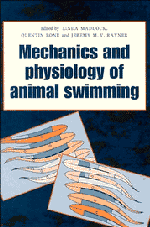Book contents
- Frontmatter
- Contents
- Contributors
- Introduction
- 1 Functional patterns of swimming bacteria
- 2 Buoyancy and swimming in marine planktonic protists
- 3 The role of fins in the competition between squid and fish
- 4 The biology of fish swimming
- 5 Swimming physiology of pelagic fishes
- 6 The mechanical design of the fish muscular system
- 7 How do fish use their myotomal muscle to swim? In vitro simulations of in vivo activity patterns
- 8 The timing of lateral muscle strain and EMG activity in different species of steadily swimming fish
- 9 Swimming in the lamprey: modelling the neural pattern generation, the body dynamics and the fluid mechanics
- 10 Swimming capabilities of Mesozoic marine reptiles: a review
- 11 Stone, bone or blubber? Buoyancy control strategies in aquatic tetrapods
- 12 Functional anatomy of the ‘flight’ apparatus in penguins
- 13 Energy conservation by formation swimming: metabolic evidence from ducklings
- Bibliography
- Index
6 - The mechanical design of the fish muscular system
Published online by Cambridge University Press: 05 March 2012
- Frontmatter
- Contents
- Contributors
- Introduction
- 1 Functional patterns of swimming bacteria
- 2 Buoyancy and swimming in marine planktonic protists
- 3 The role of fins in the competition between squid and fish
- 4 The biology of fish swimming
- 5 Swimming physiology of pelagic fishes
- 6 The mechanical design of the fish muscular system
- 7 How do fish use their myotomal muscle to swim? In vitro simulations of in vivo activity patterns
- 8 The timing of lateral muscle strain and EMG activity in different species of steadily swimming fish
- 9 Swimming in the lamprey: modelling the neural pattern generation, the body dynamics and the fluid mechanics
- 10 Swimming capabilities of Mesozoic marine reptiles: a review
- 11 Stone, bone or blubber? Buoyancy control strategies in aquatic tetrapods
- 12 Functional anatomy of the ‘flight’ apparatus in penguins
- 13 Energy conservation by formation swimming: metabolic evidence from ducklings
- Bibliography
- Index
Summary
There are many components that make up the muscular system and some show more than 1000-fold variation in nature. Why is there all this variation and by what rules does evolution set the value for a component in a particular muscular system? The results from my laboratory show that there are three simple rules or design goals by which evolution sets the values for these components. First, fibre gear ratio (Δ body movement/Δ sarcomere length) and myofilament lengths are adjusted such that the muscle fibres being used always operate at optimal myofilament overlap where near-maximal force is generated. Second, gear ratio and the maximum velocity of shortening (Vmax) are adjusted so that muscle fibres being used operate at the V/Vmax (where V is the velocity at which the muscle is shortening) where maximum power is generated and where experiments on isolated muscle suggest that efficiency is nearly optimal. Third, the rate of activation and the rate of relaxation are adjusted to be relatively slow, which may permit mechanical power to be produced with optimal efficiency. Thus the way animals produce both slow, low frequency movements and fast, high frequency movements, is by recruiting different fibre types with the appropriate gear ratio, Vmax, and kinetics of activation and relaxation.
INTRODUCTION
One of the most fascinating areas of physiology is the study of how the parameters of a given system are fine-tuned to provide optimal performance under a variety of conditions. This chapter examines how the mechanical properties of the muscular system of fish are designed to power swimming. The fish muscular system provides an exceptional model to examine the general principles of physiological design.
- Type
- Chapter
- Information
- The Mechanics and Physiology of Animal Swimming , pp. 75 - 98Publisher: Cambridge University PressPrint publication year: 1994
- 17
- Cited by

